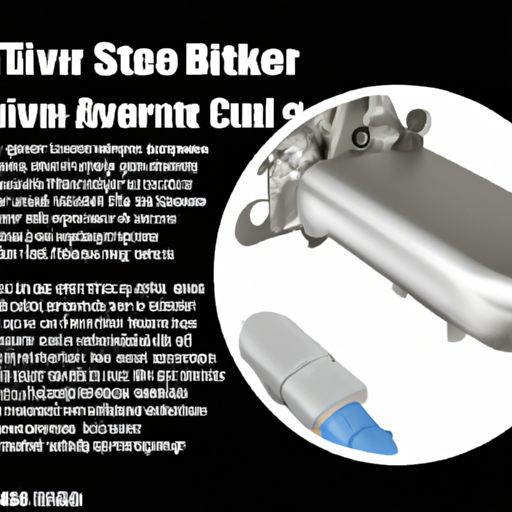Are you a proud owner of a Silverado? While this powerful and reliable truck has earned its reputation on the road, there may be some hurdles you need to overcome. One of the common challenges faced by Silverado owners is knock sensor problems. These issues can affect the engine performance and lead to decreased fuel efficiency. In this article, we will explore the potential causes and consequences of Silverado knock sensor problems, as well as provide some tips on how to address them effectively. So, let’s get started and ensure your Silverado is running smoothly and efficiently.

Common Signs of Knock Sensor Problems
Engine Misfires
One common sign of a knock sensor problem is engine misfires. The knock sensor is responsible for detecting vibrations in the engine caused by knocking or pinging. When the sensor detects abnormal vibrations, it sends a signal to the engine control module (ECM) to adjust the ignition timing and prevent engine knock. However, if the knock sensor is faulty or damaged, it may not accurately detect these vibrations, leading to improper ignition timing and engine misfires.
Decreased Fuel Efficiency
Another common sign of knock sensor problems is decreased fuel efficiency. A faulty knock sensor can cause the ECM to adjust the ignition timing too aggressively, resulting in poor fuel combustion. This can lead to decreased fuel efficiency and increased fuel consumption. If you notice that you’re filling up your gas tank more frequently than usual, it could be a sign of a knock sensor problem.
Knocking Sounds
Knocking or pinging sounds coming from the engine are also indicators of knock sensor problems. The purpose of the knock sensor is to detect these abnormal engine vibrations and prevent them from causing damage. However, if the knock sensor is not functioning properly, it may not be able to detect these vibrations, resulting in audible knocking sounds. If you hear knocking sounds coming from your engine, it’s crucial to have your knock sensor inspected and repaired promptly.
Check Engine Light
Finally, a illuminated check engine light can be a clear sign of knock sensor problems. When the ECM detects a fault with the knock sensor or its circuitry, it will trigger the check engine light to alert you of the issue. It’s important not to ignore the check engine light, as it could indicate other underlying problems with your vehicle as well. Get your vehicle diagnosed and repaired as soon as possible to prevent further damage.
Causes of Knock Sensor Problems
Faulty Wiring
One of the causes of knock sensor problems is faulty wiring. The knock sensor is connected to the ECM through a wiring harness. If there is a break or damage in the wiring, it can cause improper signal transmission between the knock sensor and the ECM. This can lead to inaccurate readings and miscommunication, resulting in knock sensor problems. Regular inspection of the wiring harness and electrical connections can help detect and resolve any wiring issues before they cause knock sensor problems.
Damaged Knock Sensor
Another cause of knock sensor problems is a damaged knock sensor itself. The knock sensor is located on the engine block or cylinder head and is exposed to the harsh conditions of the engine’s environment. Over time, the sensor can become damaged due to heat, vibration, or physical impact. A damaged knock sensor may not be able to accurately detect engine vibrations, leading to the aforementioned issues such as engine misfires and decreased fuel efficiency. If a damaged knock sensor is identified, it should be replaced as soon as possible to prevent further engine damage.
Engine Mechanical Issues
Engine mechanical issues can also cause knock sensor problems. For example, excessive carbon buildup on the pistons, worn out piston rings, or a malfunctioning EGR (exhaust gas recirculation) system can all contribute to engine knocking. The knock sensor is designed to detect abnormal engine vibrations, but if the underlying mechanical issues are not addressed, the knock sensor may continue to detect vibrations, leading to inaccurate readings and subsequent problems. It’s important to address any engine mechanical issues promptly to prevent knock sensor problems and other potential damage.
Effects of Ignoring Knock Sensor Problems
Engine Damage
Ignoring knock sensor problems can lead to severe engine damage. Engine knocking, which is detected by the knock sensor, is often caused by fuel detonation occurring at the wrong time in the engine’s combustion cycle. This can lead to excessive heat and pressure within the engine, which can damage the pistons, valves, or even the engine block itself. If knock sensor problems are left unresolved, the engine can sustain permanent damage, requiring costly repairs or even a full engine replacement.
Reduced Engine Performance
In addition to engine damage, ignoring knock sensor problems can result in reduced engine performance. When the knock sensor is not functioning properly, the engine control module may adjust the ignition timing too aggressively or not enough, affecting the engine’s power delivery and overall performance. This can lead to a decrease in acceleration, sluggishness, and a general lack of power. Ignoring these performance issues can affect your driving experience and may even pose safety risks, particularly in situations where quick acceleration is needed.
Costly Repairs
Ignoring knock sensor problems can ultimately result in costly repairs. As mentioned earlier, engine damage can occur if knock sensor problems are left unresolved. Repairing or replacing damaged engine components can be expensive, and in severe cases, it may require a complete engine overhaul or replacement. Additionally, the decrease in fuel efficiency and engine performance can lead to increased fuel consumption and added expenses at the gas pump. It’s important to address knock sensor problems promptly to avoid these costly repairs and expenses.
Troubleshooting Knock Sensor Problems
Scan for Error Codes
When experiencing knock sensor problems, the first step in troubleshooting is to scan for error codes using a diagnostic scanner. Connecting the scanner to the vehicle’s onboard diagnostics (OBD) port allows you to retrieve error codes stored in the ECM’s memory. These error codes can provide valuable information about the specific knock sensor issue and other related problems. By knowing the error codes, you can narrow down the troubleshooting process and focus on the identified circuit or component.
Inspect Wiring and Connectors
After scanning for error codes, it’s essential to inspect the knock sensor’s wiring and connectors. Faulty wiring or loose connections can affect the knock sensor’s performance and signal transmission. Visually inspect the wiring harness for any signs of damage, such as exposed wires, fraying, or corrosion. Additionally, ensure that the connectors are securely attached and free of dirt or debris. If any wiring or connectors are damaged, they should be repaired or replaced accordingly.
Test Knock Sensor
To determine if the knock sensor is functioning properly, a sensor test can be performed. This is typically done using a multimeter to measure the resistance or voltage output of the knock sensor. Detailed procedures for testing the knock sensor can be found in the vehicle’s service manual or obtained from a reputable source. If the test reveals that the knock sensor is faulty or not within the specified parameters, it should be replaced to restore proper engine performance.
Check Engine Compression
Lastly, checking the engine compression can help identify any underlying mechanical issues that can cause knock sensor problems. Low engine compression can lead to engine knocking, which may trigger the knock sensor. Performing a compression test can determine if the engine’s cylinders are maintaining adequate compression. Low compression levels may indicate worn-out piston rings, cylinder head gasket leaks, or other mechanical issues that require repair or replacement.

Replacing a Knock Sensor
Locating the Knock Sensor
The first step in replacing a knock sensor is locating its position on the engine. In most vehicles, the knock sensor is located on the engine block or the cylinder head, typically near the intake manifold or exhaust system. Consult your vehicle’s service manual or online resources to find the exact location of the knock sensor specific to your vehicle’s make and model.
Removing the Old Knock Sensor
Once the knock sensor’s location is identified, carefully disconnect the electrical connector attached to the sensor. Use the appropriate socket or wrench to remove the sensor from its mounting position. Take extra care not to damage the threads or surrounding components during removal.
Installing the New Knock Sensor
Before installing the new knock sensor, inspect the mounting area for any debris or corrosion. Clean the area if necessary to ensure a proper fit. Screw the new knock sensor into place using the appropriate socket or wrench, making sure it is tightly secured. Reconnect the electrical connector to the new sensor, ensuring a secure connection. Double-check the sensor’s alignment and make any necessary adjustments to ensure proper contact.
Preventive Measures to Avoid Knock Sensor Problems
Regular Maintenance
Implementing regular maintenance practices can help prevent knock sensor problems. This includes following the recommended maintenance schedule provided by the vehicle manufacturer, which typically includes regular oil changes, air filter replacements, and spark plug inspections/replacements. Regular maintenance helps keep the engine in optimal condition and reduces the chances of engine knocking, which can contribute to knock sensor problems.
Using Quality Fuel
Using high-quality fuel can also help prevent knock sensor problems. Low-quality or contaminated fuel can contribute to engine knocking due to poor combustion. It’s important to use fuel from reputable gas stations that meet the required quality standards. Additionally, consider using fuel additives that help keep the fuel system clean and improve combustion efficiency, reducing the likelihood of engine knocking and resulting knock sensor issues.
Avoiding Overheating
Overheating can lead to engine knocking, which can trigger knock sensor problems. To avoid overheating, make sure the vehicle’s cooling system is properly maintained. Regularly check the coolant level, inspect hoses for leaks or damage, and ensure the radiator is clean and free from debris. Additionally, avoid excessive idling or prolonged periods of driving under heavy load, as these conditions can increase the engine’s temperature and contribute to overheating and subsequent engine knocking.

Dealing with False Knock Sensor Codes
Using High-Quality Fuel
False knock sensor codes can sometimes be triggered by low-quality or contaminated fuel. Switching to high-quality fuel can help minimize false knock sensor codes. High-quality fuel contains additives that improve combustion efficiency and reduce the likelihood of engine knocking. By using high-quality fuel, you can help prevent false knock sensor codes from occurring and ensure accurate engine performance.
Addressing Engine Misfires
Engine misfires can also trigger false knock sensor codes. It’s important to address any engine misfires promptly to prevent false codes. Misfires can be caused by various factors such as faulty spark plugs, ignition coils, or fuel injectors. Regularly inspect and maintain these components, and replace them as needed to avoid misfires and false knock sensor codes.
Inspecting the Engine for Mechanical Issues
False knock sensor codes can also be triggered by underlying mechanical issues within the engine. Inspect the engine for any mechanical problems such as worn-out piston rings, excessive carbon buildup, or malfunctioning EGR valve. Addressing these mechanical issues can help prevent false knock sensor codes and ensure the proper functioning of the knock sensor.
Recalls and Technical Service Bulletins (TSBs)
Checking for Silverado Recalls
If you own a Silverado truck and suspect knock sensor problems, it’s important to check for any recalls specifically related to the knock sensor. Recalls are issued by vehicle manufacturers to address safety-related issues and defects. To check for recalls, visit the official website of the vehicle manufacturer or contact their customer service with your vehicle identification number (VIN). If there is an unresolved recall related to the knock sensor, follow the manufacturer’s instructions to have the issue resolved at an authorized dealership.
Reviewing TSBs for Knock Sensor Issues
Technical Service Bulletins (TSBs) are documents issued by vehicle manufacturers to provide authorized dealerships with information and guidance on specific issues. These bulletins often include instructions on how to diagnose and repair common problems, including knock sensor issues. Reviewing TSBs relevant to the Silverado knock sensor problems can provide valuable insights and guidance for proper diagnosis and repair. TSBs can usually be obtained from the vehicle manufacturer’s website or by contacting their customer service.

FAQs about Silverado Knock Sensor Problems
What is the purpose of a knock sensor?
The purpose of a knock sensor is to detect abnormal engine vibrations, often caused by engine knocking or pinging. When the knock sensor detects these vibrations, it sends a signal to the engine control module (ECM) to adjust the ignition timing and prevent further engine damage.
Are knock sensor problems common in Silverado trucks?
Knock sensor problems can occur in any vehicle, including Silverado trucks. However, the prevalence of knock sensor problems can vary depending on factors such as the vehicle’s age, mileage, and maintenance history. It’s important to address any signs of knock sensor problems promptly to avoid potential engine damage.
Can a knock sensor be cleaned instead of replaced?
In some cases, a knock sensor may become dirty or covered in oil, affecting its performance. If the sensor is not damaged and the issue is related to dirt or oil buildup, it may be possible to clean the sensor instead of replacing it. However, it’s important to consult the vehicle’s service manual or a reputable source for specific cleaning instructions. If the sensor is damaged or not functioning properly, replacement is necessary to ensure accurate engine performance.
Conclusion
In conclusion, knock sensor problems can have significant effects on your vehicle’s engine performance and longevity. Recognizing the common signs of knock sensor problems, understanding their causes, and taking proper preventive measures can help you avoid costly repairs and maintain optimal engine performance. If you encounter knock sensor problems, it’s crucial to troubleshoot, diagnose, and repair the issue promptly to prevent further engine damage. Regular maintenance, using high-quality fuel, and addressing potential mechanical issues are key to ensuring the proper functioning of your vehicle’s knock sensor system.

